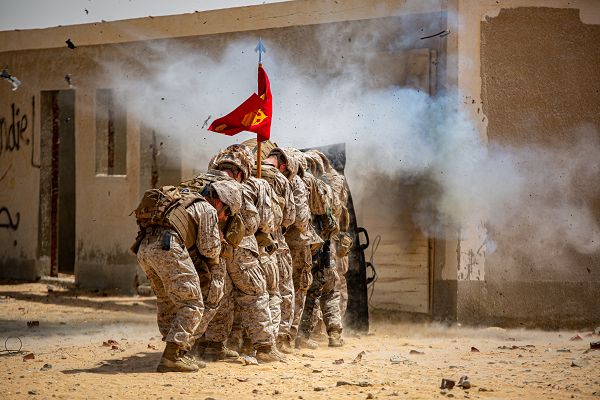
Mohamed Naguib Military Base, Egypt. (Sept. 7, 2023): In this photo by Captain Mark Andries, U.S. Marines from 4th Combat Engineer Battalion, 4th Marine Division detonate an explosive to blast open a door while practicing breaching techniques with Egyptian troops during exercise Bright Star 23. This multilateral exercise, hosted by the U.S. Central Command, offered a chance to work with Arab Republic of Egypt combat engineers on the essential tools of urban warfare.
Going door-to-door after the enemy and needing help getting through a door?
Call the 4th Combat Engineer Battalion, a reserve unit based in Baltimore, Maryland that is part of the Marine Forces Reserve. In the close quarters fighting in Iraq, these Marines and their “breaching” skills were in much demand.
Marine Combat Engineers “breach” doors or walls using five different methods; mechanical breaching, ballistic breaching, hydraulic breaching, explosive breaching, or thermal breaching. Marines use a combination of explosives, thermal devices, and mechanical breaching equipment to penetrate virtually any structure. In urban combat situations, combat engineers often lead the way by clearing obstacles, defusing explosives, or accompanying infantry units clearing buildings door-to-door.
Naturally, this is some of the most dangerous work in the Marine Corps.
Marine Combat engineers can trace their roots to the armies of Greece in 1884 B.C. These ancient engineers constructed the famous Trojan Horse that was used to infiltrate the city of Troy and end the war. In the Civil War, combat engineers helped build fortifications and designed earthworks to protect military units from aerial bombardment. They also famously dug tunnels under enemy encampments and detonated massive explosions that often decided the outcome of the battle. During World War II, engineers first developed their bridge building ability by crossing hundreds of hotly contested waterways like the Rhine River in Germany. The engineers were also critical to clearing mines and obstacles on the beaches on D-Day.
More recently, Marine Combat Engineers deployed to Operation Enduring Freedom to tackle a worsening improvised explosive device (IED) problem that was killing and injuring their fellow Marines. Service members in the Middle East came to rely on combat engineers to detect various kinds of IEDs and to clear the way for others to safely follow. The combat engineers are the unsung heroes of the battlefield, risking their lives while clearing a safe path for others.


